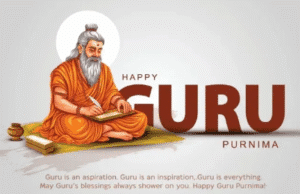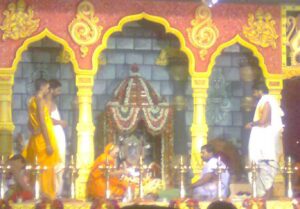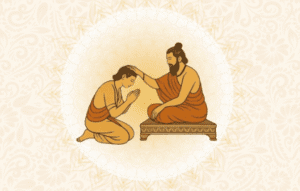 Every year, the full moon in the Hindu month of Ashadha (June–July) brings with it Guru Purnima—a sacred occasion dedicated to spiritual teachers and the power of gratitude. In 2025, this auspicious day falls on Thursday, July 10. Rooted in ancient tradition yet resonant for modern seekers, Guru Purnima honors the lineage of wisdom—from ancient rishis to contemporary mentors—and seeks to foster an awakened mindset through reverence, reflection, and selfless service.
Every year, the full moon in the Hindu month of Ashadha (June–July) brings with it Guru Purnima—a sacred occasion dedicated to spiritual teachers and the power of gratitude. In 2025, this auspicious day falls on Thursday, July 10. Rooted in ancient tradition yet resonant for modern seekers, Guru Purnima honors the lineage of wisdom—from ancient rishis to contemporary mentors—and seeks to foster an awakened mindset through reverence, reflection, and selfless service.
This guide explores the festival’s meaning, its timeless stories, essential rituals, and modern observances. Dive in to discover how observing Guru Purnima can bring clarity, humility, and spiritual growth into your life.
Why July 10, 2025, Is Guru Purnima – Marking the Full Moon of Ashadha
Guru Purnima literally translates to “Teacher’s Full Moon”—the brightest night of the lunar Virgo month. In 2025, the full moon aligns on July 10, making it the most spiritually potent day of the year to honor gurus—natural, lineage-based, or personal guides.
According to lunar tradition, the energy of the full moon enhances spiritual practices like meditation and chanting. Combined with the reverence due on Guru Purnima, the day becomes a gateway to deeper transformation.
The Ancient Origins of Guru Purnima
The Story of Maharshi Vyasa
Widely regarded as the first and greatest guru of the Vedic age, Maharshi Vyasa is credited with compiling the Mahabharata, the Vedas, and the Puranas—sacred texts that form the backbone of Sanatana Dharma. Legend holds that he was born on this full moon in the month of Ashadha, establishing a spiritual precedent that devotees celebrate today by honoring gurus and seekers alike.
 Buddha’s Enlightenment under the Full Moon
Buddha’s Enlightenment under the Full Moon
In Buddhist traditions, the full moon of Ashadha also marks the time when Gautama Buddha gave his first sermon at Sarnath—an event celebrated as “Dhamma Chakra Pravartana.” Thus, Guru Purnima is revered by both Hindus and Buddhists as a day when wisdom began to spread through profound guidance.
The Spiritual Significance of Guru Purnima
Guru Purnima is more than a ceremony—it’s a mirror for internally honoring wisdom and humility. The word “guru” means “dispeller of darkness.” By acknowledging our teachers, we humbly admit our limitations and open ourselves to higher knowledge.
The day is ideal for:
- Honoring gratitude for those who guide us
- Spiritual reflection on teachings received
- Mindful seva, offering selfless service to others, especially mentors
- Guru-mantra meditation, deepening our connection to inner guidance
Traditional Rituals and Celebrations
Guru Puja and Offerings
Early morning puja is the heart of the day. Disciples offer flowers, fruit, incense, and cloth to their guru or their altar. They place their hands respectfully at the feet of their guru, receiving guru-dakshina—a token of gratitude that may be material or simply a loving commitment.
 Chanting and Scriptural Study
Chanting and Scriptural Study
Recitations of the Gayatri mantra, Guru-stotras, and verses from the Vedas or the Bhagavad Gita are common. These collective chants help dissolve ego and invoke awareness.
Morning and evening satsangs bring seekers together in bhajan singing and group meditation, spreading devotional energy under the full moon.
Fasting and Spiritual Renewal
Some observe a vrat (fast) through the day, consuming fruits and water only. This practice of self-discipline fosters clarity and focus, essential for spiritual transformation.
Land Seva (Community Service)
Serving teachers, spiritual organizations, or needy communities—called seva—is a tangible expression of gratitude and humility. Many temples and ashrams organize food distribution, teaching sessions, or cleaning drives on Guru Purnima.
Modern Observances: Adapting Tradition to Today
Today’s seekers often work with online gurus, spiritual podcasts, and video satsangs. Social media platforms like Instagram and YouTube are filled with Guru Purnima tributes, guided meditations, and reflections.
Similarly, urban spiritual centers hold virtual pujas, yoga sessions, and web-based gratitude circles. This digital evolution helps Guru Purnima reach those who cannot access a physical guru, without diluting its devotional power.
Famous Gurus and Their Legacy
Over centuries, numerous gurus have shaped spiritual evolution:
- Adi Shankaracharya, who revitalized Advaita Vedanta
- Sri Ramana Maharshi, teacher of self-inquiry
- Krishnamurti, exploring freedom from beliefs
- Mahatma Gandhi, who lived his message of ahimsa, truth, and community
Honoring these figures reminds us of the practical embodiment of wisdom and humility.
Sanskrit Shloka for Guru Purnima
गुरुर्ब्रह्मा गुरुर्विष्णुर्गुरुर्देवो महेश्वरः ।
गुरु साक्षात् परं ब्रह्म तस्मै श्रीगुरवे नमः॥
Translation:
The Guru is Brahma, Vishnu, and Maheshwara; the Guru is verily the Supreme Brahman. Salutations to that Guru.
Why Celebrating Guru Purnima Matters Today
Gratitude in a Noisy World
On a day saturated with deadlines and distractions, pausing to honor those who light our way is an antidote to living on autopilot.
Renewing Spiritual Discipline
Whether it’s daily meditation, seva, or reflection, Guru Purnima offers a time to reboot our spiritual practices and realign with our highest values.
Building Intergenerational Bridges
Today’s youth pair digital wisdom with ancient lineage. On this day, students can reconnect with elders—mentors in schools, yoga, or crafts, to restore respect and continuity.
Mental and Emotional Benefits
Research links gratitude and community service to increased life satisfaction, lower stress levels, and improved perspective—benefits that extend far beyond the vows of one spiritual day.
How to Observe Guru Purnima Mindfully
- Wake at dawn and perform a simple prayer or meditation.
- Offer flowers or fruit, or symbolically dedicate actions—like reading or writing—as guru seva.
- Engage in selfless service: cook for someone else, volunteer, or mentor quietly.
- Journal on “What have I received from my teachers?” and “How can I pay it forward?”
- End the day in silence, practicing gratitude before the full moon.
These small acts create ripples of transformation—inner and outer.
Real-Life Reflections
- A young student wrote: “On Guru Purnima, I thanked my college mentor. For years chased grades; that day, I realized I was missing wisdom beyond scorecards.”
- A retiree shared: “Our neighborhood organized seva—cleaning around a temple. Strangers became friends in minutes, all due to the Guru Purnima spirit.”
These stories show how spiritual practice reconnects us with community and purpose.
Final Thoughts: A Festival That Transcends Time
Guru Purnima 2025, falling on July 10, asks us to remember that wisdom isn’t just knowledge—it’s lived. It’s not just spoken—it’s surrendered. In a world searching for quick fixes, this day offers the radical invitation to slow down, feel gratitude, and realign with what matters.
Whether you honor a traditional guru or the everyday teachers around you, take a moment under the full moon to bow in humility and thanks.
📩 Join the Spiritual Path
Are you ready to deepen your mindfulness and spiritual devotion?
👉 Join the Mindful Movement to receive weekly guides, virtual pujas, and reflections rooted in timeless wisdom.

